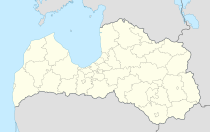Piltene
| Piltene ( German : Pilten) | ||
|---|---|---|
 |
|
|
| Basic data | ||
| State : |
|
|
| Landscape: | Courland ( Latvian : Kurzeme ) | |
| Administrative district : | Ventspils novads | |
| Coordinates : | 57 ° 14 ' N , 21 ° 41' E | |
| Residents : | 1,053 (Jul 1, 2010) | |
| Area : | 14.2 km² | |
| Population density : | 74 inhabitants per km² | |
| Height : | ||
| City law: | since 1557 | |
| Website: | www.ventspilsnovads.lv | |
| Post Code: | ||
| ISO code: | ||
| Pilten castle ruins and church | ||
Piltene ( German Pilten , Polish Piltyń ) is a city in the northwestern part of Courland in Latvia on the Venta River .
history
Before Windau was founded, the river port was the main hub for trade from inland. The distance to the Baltic Sea meant protection from the Vikings . There are hypotheses that a castle of the Danish King Waldemar II (1170–1241) was located here.
In 1309 a Pilten castle in the diocese of Courland was first mentioned in writing. This remained the bishop's residence for 250 years. In 1330 the castle was besieged by Lithuanians in vain. A plague epidemic is reported in 1350. Under Bishop Johann von Münchhausen (1542–1560) economically efficient Jewish settlers moved to Pilten. The city became Lutheran with the Reformation and received city rights in 1557. In 1560 Magnus of Denmark became the last bishop in Piltene. His death in 1583 was the cause of the Pilten War of Succession .
After a time under Prussian administration, the Piltene district came under the direct rule of Poland-Lithuania until 1795 as part of the Livonia Voivodeship . The Diocese of Courland became the Diocese of Pilten . The neighboring Aizpute now became the center of the circle . In 1621 the castle was already in ruins and the city became meaningless.
The time in the Russian Governorate of Courland brought a slight economic upturn. In 1885 Pilten had 1507 inhabitants. Until the First World War , Jews and Germans formed the largest population group. From 1920, the Latvians then predominated due to emigration and immigration.
During the time of the Latvian SSR , the population decreased as there were no significant industrial establishments.
After the regaining of Latvian independence in 1990/1991, a nursery for vegetables and medicinal herbs with 250 employees was the largest employer.
Others
- The city was spared from fighting during the world wars. That is why there are still some wooden buildings from the beginning of the 19th century, which are of architectural and craft value due to their construction.
- There is a pre-school, a primary school and a middle school in Piltene.
- The sports stadium is used by FK Ventspils .
people
- Ulrich von Heyking (1718–1790), Prussian major general
literature
- H. von Bienenstamm (= Herbord Carl Friedrich von Bienenstamm): Geographical outline of the three German Baltic Sea provinces of Russia, or the governorates of Ehst-, Liv- and Kurland. Deubner, Riga 1826, p. 440 f. ( online at Google Books )
- Hans Feldmann , Heinz von zur Mühlen (Hrsg.): Baltic historical local dictionary, part 2: Latvia (southern Livland and Courland). Böhlau, Cologne 1990, ISBN 3-412-06889-6 , pp. 468-470.
- Astrīda Iltnere (ed.): Latvijas Pagasti, Enciklopēdija. Preses Nams, Riga 2002, ISBN 9984-00-436-8 .
- Sigurds Rusmanis, Ivars Vīks: Kurzeme . Izdevniecība Latvijas Enciklopēdija, Riga 1993, ISBN 5-89960-030-6 , pp. 56-57.
Web links
Individual evidence
- ↑ Sigurds Rusmanis, Ivars Vīks: Kurzeme . Izdevniecība Latvijas Enciklopēdija, Riga 1993, ISBN 5-89960-030-6 , p. 56.
- ↑ Bogusław Dybas: pin Pilten or circle Pilten? A contribution to the denominational politics of Poland-Lithuania in Livonia in the 17th century . In: Joachim Bahlcke (ed.): Confessional plurality as a challenge. Coexistence and Conflict in the Late Middle Ages and Early Modern Times . Leipziger Universitätsverlag, Leipzig 2006, ISBN 3-86583-081-1 , pp. 507-520, here p. 516.

